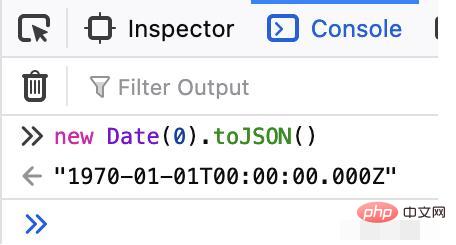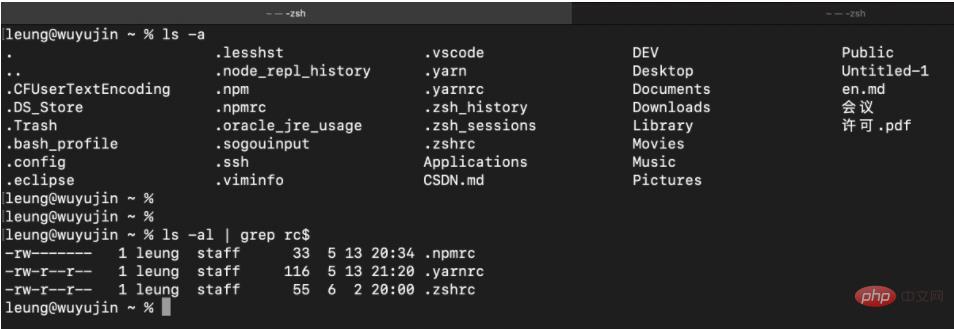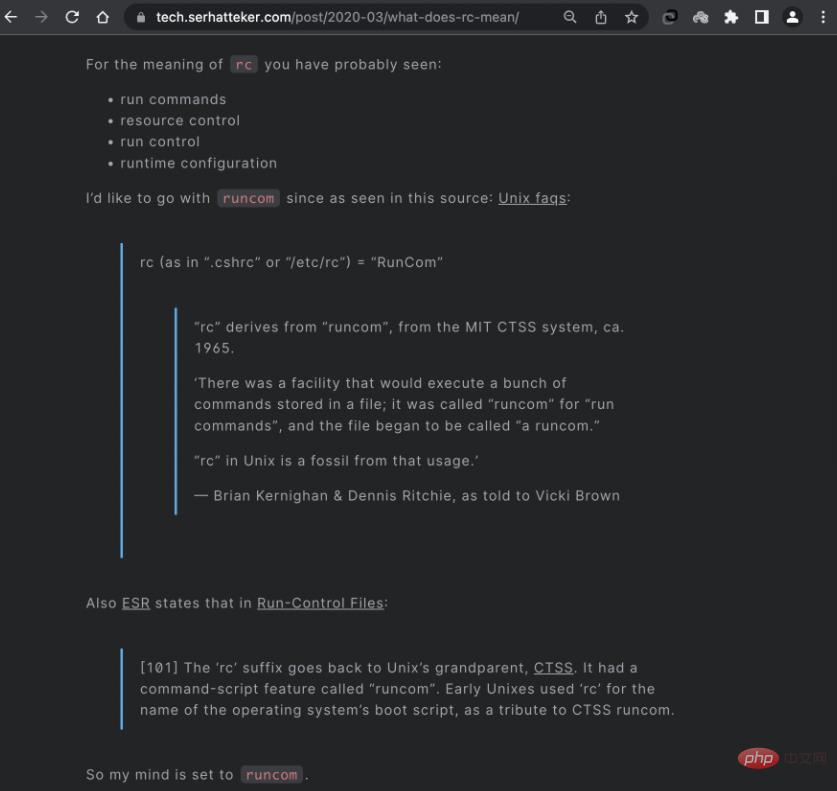ホームページ >運用・保守 >Linuxの運用と保守 >Linux rc とはどういう意味ですか?
Linux rc とはどういう意味ですか?
- 藏色散人オリジナル
- 2023-03-16 09:33:122803ブラウズ
linux rc は runcom の略語で、「.cshrc」または「/etc/rc」に表示される rc でもあります。rc は、1965 年に MIT CTSS システムに初めて登場した runcom に由来します。一部のシナリオでは、ファイルに保存されている複数のコマンドを実行します。これを runcom と呼びます。これは run コマンドの略です。

Linux rc とはどういう意味ですか?
Linux rc の完全な意味
これは、先史時代に由来しています。 Unix システム (1961 ~ 1969 年) の初期に、MIT は互換性のあるタイムシェアリング システム (CTSS) を開発しました。 (この CTSS の機能は、後の Unix システムほど優れているわけではありませんが、かなり古いものです。)
CTSS システムには、
runcom と呼ばれるコマンド スクリプトに関する機能があります。 。 Unix システムの初期バージョンである CTSS の runcom 機能に敬意を表するため、後の Unix システムでは
rc がオペレーティング システムの起動ファイル名として使用されました。
プログラミング言語の日付は 1970-01-01、
CTSSシステムの「高級感」は側面からも感じられます。
意味
rc = RunCom
run コマンド と呼ばれ、「runcom」とも呼ばれ、この種のファイルはruncom (ランコム) と呼ばれます。"
Example
- .bashrc
bash 実行コマンド - .vimrc
Vim の実行コマンド - .npmrc
npm の実行コマンド
. で始まるファイル名隠しファイルとして表現されます。

leung@wuyujin ~ % ls -al | grep rc$ -rw------- 1 leung staff 33 5 13 20:34 .npmrc -rw-r--r-- 1 leung staff 116 5 13 21:20 .yarnrc -rw-r--r-- 1 leung staff 55 6 2 20:00 .zshrc
参考bashr、zshrc、vimrc などでの rc の意味は何ですか?
bashr、zshrc、vimrc での rc の意味は何ですか? etc?
rc の意味については、次のようになります。
- runコマンド
- リソース制御
- 実行制御
- ランタイム構成
rc は runcom の略称です。
rc = RunCom は、.cshrc または /etc/rc に表示される rc# です。 ##rc
は、1965 年に MIT CTSS システムに初めて登場した runcom に由来しています。 一部のシナリオでは、ファイルに保存されている複数のコマンド
を実行します。これを runcom と呼びます。つまり、コマンドを実行しますrun の略語コマンド。 さらに、コマンドの保存に使用されるファイルは a runcom
と呼ばれます。 Unix ファイル名の rc
は、この古い暗示に由来しています。 — ブライアン・カーニハンとデニス・リッチー、ヴィッキー・ブラウンに語った話
また、ESR は実行制御ファイルに次のように述べています:
rc suffix を最後まで遡ってみると、Unix システムの祖父である CTSS に実際に存在していることがわかります。 CTSS の古いシステムには、
runcom と呼ばれるコマンド スクリプト機能があります。 したがって、Unix の初期には、CTSS runcom を思い出し、敬意を表するため、
rc がオペレーティング システム起動スクリプトのファイル名として使用されていました。
したがって、rc は
の省略形であると考えられます。
CTSS(Compatible Time-Sharing System)兼容分时系统
Unix系统的背景
1961-1969:史前时代
CTSS(Compatible Time-Sharing System,兼容分时系统),以MIT为首的开发小组,小而简单的实验室原型。
Multics(Multiplexed Information and Computing System,多路信息与计算系统),庞大而负责,不堪重负。
Unics(Uniplexed information and Computing System,单路信息与计算系统),返璞归真,走上正道。
1969-1971:创世纪
……
参考 Unix - Frequently Asked Questions (1/7) [Frequent posting]Section - What does {some strange unix command name} stand for
1.3) What does {some strange unix command name} stand for?
awk = "Aho Weinberger and Kernighan"
This language was named by its authors, Al Aho, Peter
Weinberger and Brian Kernighan.
grep = "Global Regular Expression Print"
grep comes from the ed command to print all lines matching a
certain pattern
g/re/p
where "re" is a "regular expression".
fgrep = "Fixed GREP".
fgrep searches for fixed strings only. The "f" does not stand
for "fast" - in fact, "fgrep foobar *.c" is usually slower than
"egrep foobar *.c" (Yes, this is kind of surprising. Try it.)
Fgrep still has its uses though, and may be useful when searching
a file for a larger number of strings than egrep can handle.
egrep = "Extended GREP"
egrep uses fancier regular expressions than grep. Many people
use egrep all the time, since it has some more sophisticated
internal algorithms than grep or fgrep, and is usually the
fastest of the three programs.
cat = "CATenate"
catenate is an obscure word meaning "to connect in a series",
which is what the "cat" command does to one or more files. Not
to be confused with C/A/T, the Computer Aided Typesetter.
gecos = "General Electric Comprehensive Operating Supervisor"
When GE's large systems division was sold to Honeywell,
Honeywell dropped the "E" from "GECOS".
Unix's password file has a "pw_gecos" field. The name is a
real holdover from the early days. Dennis Ritchie has reported:
"Sometimes we sent printer output or batch jobs
to the GCOS machine. The gcos field in the password file
was a place to stash the information for the $IDENT card.
Not elegant."
nroff = "New ROFF"
troff = "Typesetter new ROFF"
These are descendants of "roff", which was a re-implementation
of the Multics "runoff" program (a program that you'd use to
"run off" a good copy of a document).
tee = T
From plumbing terminology for a T-shaped pipe splitter.
bss = "Block Started by Symbol"
Dennis Ritchie says:
Actually the acronym (in the sense we took it up; it may
have other credible etymologies) is "Block Started by
Symbol." It was a pseudo-op in FAP (Fortran Assembly [-er?]
Program), an assembler for the IBM 704-709-7090-7094
machines. It defined its label and set aside space for a
given number of words. There was another pseudo-op, BES,
"Block Ended by Symbol" that did the same except that the
label was defined by the last assigned word + 1. (On these
machines Fortran arrays were stored backwards in storage
and were 1-origin.)
The usage is reasonably appropriate, because just as with
standard Unix loaders, the space assigned didn't have to be
punched literally into the object deck but was represented
by a count somewhere.
biff = "BIFF"
This command, which turns on asynchronous mail notification,
was actually named after a dog at Berkeley.
I can confirm the origin of biff, if you're interested.
Biff was Heidi Stettner's dog, back when Heidi (and I, and
Bill Joy) were all grad students at U.C. Berkeley and the
early versions of BSD were being developed. Biff was
popular among the residents of Evans Hall, and was known
for barking at the mailman, hence the name of the command.
Confirmation courtesy of Eric Cooper, Carnegie Mellon University
rc (as in ".cshrc" or "/etc/rc") = "RunCom"
"rc" derives from "runcom", from the MIT CTSS system, ca. 1965.
'There was a facility that would execute a bunch of
commands stored in a file; it was called "runcom" for "run
commands", and the file began to be called "a runcom."
"rc" in Unix is a fossil from that usage.'
Brian Kernighan & Dennis Ritchie, as told to Vicki Brown
"rc" is also the name of the shell from the new Plan 9
operating system.
Perl = "Practical Extraction and Report Language"
Perl = "Pathologically Eclectic Rubbish Lister"
The Perl language is Larry Wall's highly popular
freely-available completely portable text, process, and file
manipulation tool that bridges the gap between shell and C
programming (or between doing it on the command line and
pulling your hair out). For further information, see the
Usenet newsgroup comp.lang.perl.misc.
Don Libes' book "Life with Unix" contains lots more of these
tidbits.
相关推荐:《Linux视频教程》
以上がLinux rc とはどういう意味ですか?の詳細内容です。詳細については、PHP 中国語 Web サイトの他の関連記事を参照してください。

